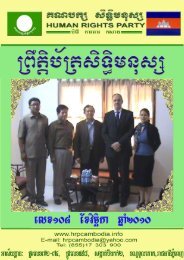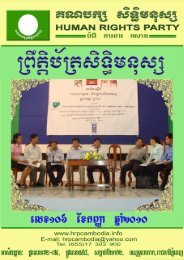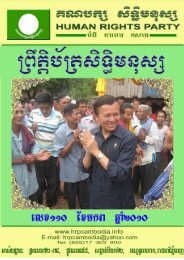Losing Ground - Human Rights Party.
Losing Ground - Human Rights Party.
Losing Ground - Human Rights Party.
Create successful ePaper yourself
Turn your PDF publications into a flip-book with our unique Google optimized e-Paper software.
<strong>Losing</strong> <strong>Ground</strong><br />
The Sekong has its origins in the highlands of Vietnam,<br />
then flows south through Laos and into Stung Treng where<br />
it reaches the Sesan and Srepok. The rivers support the<br />
livelihoods of tens of thousands of people in Vietnam, Laos<br />
and Cambodia, including many indigenous groups that live<br />
along the banks.<br />
Several new dams are under construction or planned<br />
upstream along the rivers in Laos and Vietnam, and the<br />
impacts are disrupting villages in Ratanakkiri and Stung<br />
Treng provinces.<br />
“We are facing a lot of projects and we have to be<br />
considering the combined impact across the [Sekong River]<br />
Basin,” Richard Friend of World Fish said.<br />
“It’s not about dollars; It’s a way of life. It’s about food,”<br />
according to Canadian human geography researcher Ian<br />
Baird, explaining that many of these river villages are a few<br />
days walk from a market, and if there is no fish, residents<br />
must walk to the market to buy goods. “Their lives depend<br />
upon the river.”<br />
Surges on the Sesan<br />
A 2006-07 study in Ratanakkiri found that 772 families<br />
comprising 3,545 people from 17 villages and eight<br />
communes located along the river’s four districts have<br />
abandoned their homes along the Sesan River to move to<br />
higher land. Most of the families are indigenous people.<br />
The group that left represented about a fifth of the river<br />
population of 4,071 families in 56 villages and 14 communes<br />
of the four districts living along the Sesan River in Ratanakiri<br />
province.<br />
The study, Abandoned Villages along the Sesan River in<br />
Ratanakkiri Province reported that the people were moving<br />
away because flooding was destroying their rice paddy and<br />
vegetable gardens and because sudden surges in water levels<br />
were frightening. The fish catch was declining due to the<br />
changes in the river, and people complained about food<br />
shortages.<br />
The surges are caused by releases from new dams upstream<br />
in Vietnam.<br />
On February 8, 2009, three villages in Ratanakkiri<br />
province’s Vuen Sai and Andong Meas districts reported<br />
a one-meter rise in the level of the river, which became<br />
“unusually turbid,” according to the Sesan, Srepok and<br />
Sekong Rivers Protection Network (3SPN). Spokesman<br />
Kim Sangha said the surge was caused by tests at the new<br />
Sesan 4 dam in Vietnam.<br />
Thun Bunhean, from Deilo village in Lumpat district in<br />
Rattanakkiri, said once the water flowed so fast that “my<br />
villagers and I could not have enough time to prevent our<br />
cows, pigs, chickens and ducks from being carried away by<br />
the water… and now we have nothing to eat.”<br />
Flooding on the Srepok<br />
Representatives in Stung Treng province have also been<br />
experiencing unnatural flooding. The News Mekong service<br />
(www.newsmekong.org) reported that flooding comes two<br />
or three times a year along the Srepok River.<br />
Chao Chantha, 46, said that the floods have been occurring<br />
since 2004 and in her village in Banmei, many families have<br />
moved out. She said some families have stayed even though<br />
their fields are flooded two or three times per year.<br />
Cambodia’s Dam Plans<br />
As Cambodia struggles to find new sources of electricity, it has<br />
launched its own hydropower projects on rivers all around the<br />
country, and the experiences of the people in Stung Treng may<br />
be a forbearer of what is to come in other areas of Cambodia.<br />
Chinese companies and state banking entities are financing<br />
much of this hydropower investment, a result of Cambodia’s<br />
Forced Evictions and Intimidation in Cambodia<br />
53






